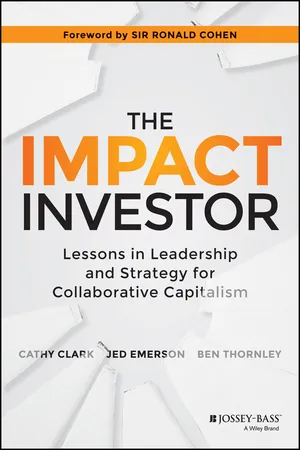
The Impact Investor
Lessons in Leadership and Strategy for Collaborative Capitalism
Cathy Clark, Jed Emerson, Ben Thornley
- English
- ePUB (adapté aux mobiles)
- Disponible sur iOS et Android
The Impact Investor
Lessons in Leadership and Strategy for Collaborative Capitalism
Cathy Clark, Jed Emerson, Ben Thornley
À propos de ce livre
Your money can change the world
The Impact Investor: Lessons in Leadership and Strategy for Collaborative Capitalism offers precise details on what, exactly, impact investing entails, embodied in the experiences and best and proven practices of some of the world's most successful impact investors, across asset classes, geographies and areas of impact. The book discusses the parameters of impact investing in unprecedented detail and clarity, providing both context and tools to those eager to engage in the generational shift in the way finance and business is being approached in the new era of Collaborative Capitalism.
The book presents a simple thesis with clarity and conviction: "Impact investing can be done successfully. This is what success looks like, and this is what it requires." With much-needed lessons for practitioners, the authors view impact investing as a harbinger of a new, more "multilingual" (cross-sector), transparent, and accountable form of economic leadership.
The Impact Investor: Lessons in Leadership and Strategy for Collaborative Capitalism serves as a resource for a variety of players in finance and business, including:
- Investors: It demonstrates not only the types of investments which can be profitable and impactful, but also details best practices that, with roots in impact investing, will increasingly play a role in undergirding the success of all investment strategies.
- Wealth advisors/financial services professionals: With unprecedented detail on the innovative structures and strategies of impact investing funds, the book provides guidance to financial institutions on how to incorporate these investments in client portfolios.
- Foundations: The book explores the many catalytic and innovative ways for for-profit and non-profit investors to partner, amplifying the potential social and environmental impacts of philanthropic spending and market-rate endowment investment.
- Business students: By including strategies for making sound impact investments based on detailed case studies, it provides concrete lessons and explores the skills required to enhance prospects for success as a finance and business professional.
- Policy makers: Reinforcing the urgency of creating a supportive and enabling environment for impact investing, the book demonstrates ways policy has already shaped the sector, and suggests new ways for policymakers to support it.
- Corporate leaders: The book includes essential advice on the way business is and must be responding to a new generation of Millennial clients and customers, with unique insights into a form of value creation that is inherently more collaborative and outcomes-driven.
Foire aux questions
Informations
Part One
Key Practices and Drivers Underlying Impact Investing
1
Inside Collaborative Capitalism
Collaborative Capitalism is the realization of a community's highest economic and social aspirations through the enterprising deployment of ideas, capital, and shared resources in pursuit of common impact.
The Roots of Collaborative Capitalism
The Social Role and Responsibility of Business
“Capitalism, even 150 years ago, was more inclusive; there was more of a sense of social responsibility,” Dominic Barton, [the global managing director at McKinsey] told me. Today, trust in business is declining. “The system doesn't seem to be as fair or as inclusive. It doesn't seem to be helping broader society.”Barton's concern is shared by David Blood, former head of Goldman Sachs Asset Management, who cofounded Generation Investment Management with former vice president Al Gore a decade ago. “Some people say income inequality doesn't matter. I disagree,” Blood said. “We are creating a situation in which only the elite of the elite can be successful—and that is not sustainable.” Both men worry that if capitalism doesn't deliver for the middle class, then the middle class will eventually opt for something else. Barton says that business needs what he calls “a license to operate,” and without a new approach, he fears, it risks losing that license.3
Table des matières
- Cover
- Title Page
- Copyright
- Tables and Figures
- Foreword
- Preface
- Dedication
- Introduction
- Part One: Key Practices and Drivers Underlying Impact Investing
- Part Two: Four Key Elements of Successful Impact Investing
- Part Three: Looking Ahead: Trends and Challenges
- Impact Investor Resource Guide
- Acknowledgments
- About the Authors
- More from Wiley
- Index
- End User License Agreement